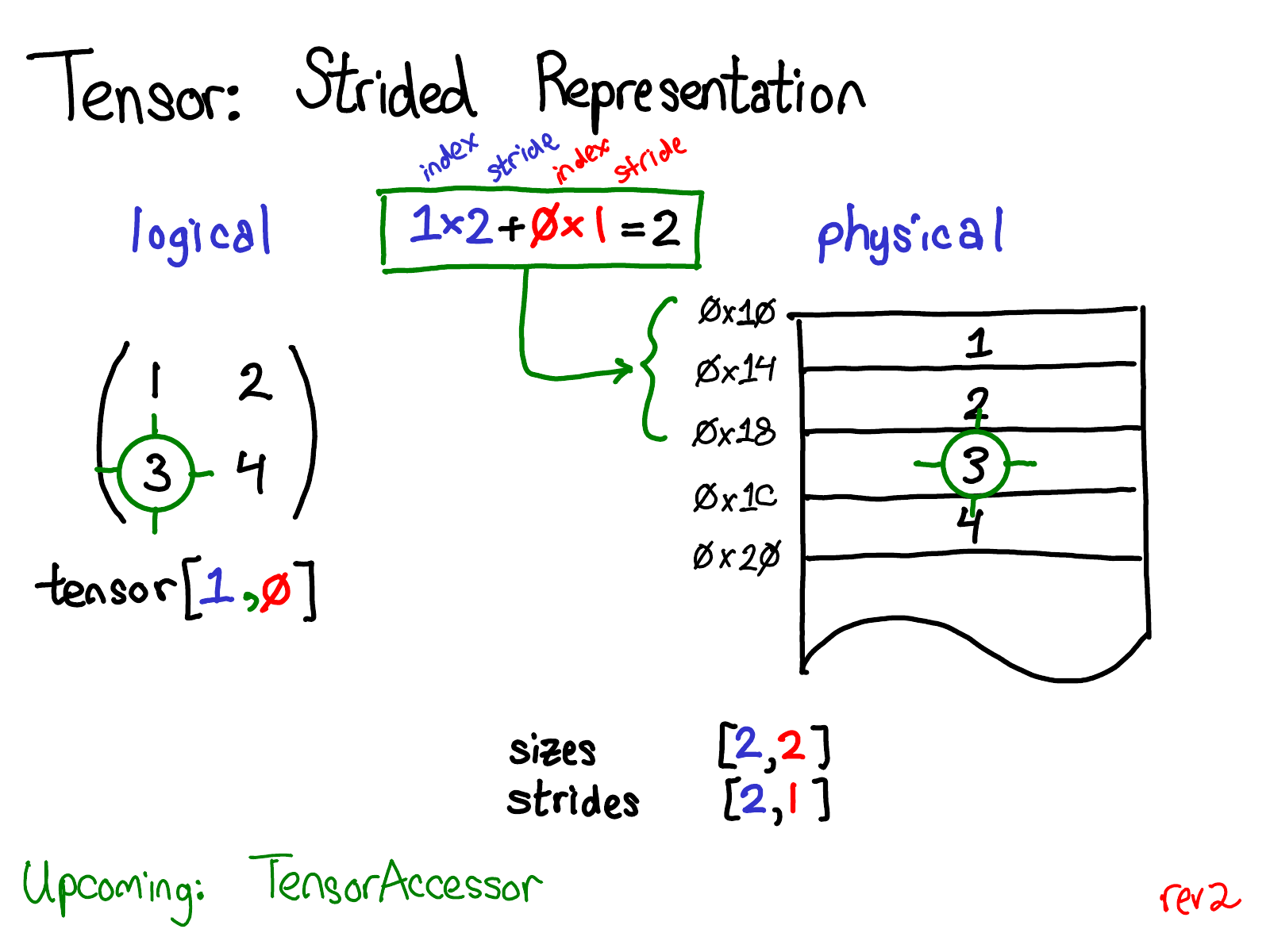In one of the Karpathy’s videos, he recommends the blogpost by Edward Z. Yang called PyTorch internals to learn about the implementation of Tensor class in Pytorch. The blogpost is fantastic and goes into detailed representation of some of the basic functionality of Tensors.
After reading the post, I tried to implement similar functionality in Go using slices. In this post, I will walk through following methods of basic Tensor stuct:
- NewTensor (Creating empty Tensor)
- At (indexing using arbitrary number of dimensions)
- View (Returning different size tensor with the same underlying slice)
- DimSlice (hardest: Getting the slice of arbitrary dimension
a[:, :, 2, :])
Full implementation code and tests can be found this repository.
Tensor struct
Basic Tensor in Pytorch has the data in one dimensional continous array, and sizes, strides, offset for getting the multi-dimensional view of the Tensor.
For detailed explanation, please refer to PyTorch internals.
type Tensor struct {
Sizes []int
Strides []int
Offset int
Data []float64
}
Creating NewTensor from data or empty
func NewTensor(data []float64, sizes []int) *Tensor {
t := Tensor{}
if len(data) == 0 {
t.Data = make([]float64, 0)
t.Sizes = make([]int, 0)
t.Offset = 0
t.Strides = make([]int, 0)
return &t
}
t.Data = data
t.Sizes = sizes
t.Offset = 0
t.Strides = calculateStrides(sizes)
return &t
}
Sizesis the dimension sizes (same as.dimor.size()in Pytorch)Stridesis the required stride of each dimension, meaning how many elements should we skip to get to next element. For example: how many elements betweena[1, 0]anda[2, 0].
To calculate the strides of Tensor given its sizes, we reverse multiply each dimension until the first one.
func calculateStrides(sizes []int) []int {
strides := make([]int, len(sizes))
inter_stride := 1
for i := len(strides) - 1; i >= 0; i-- {
strides[i] = inter_stride
inter_stride *= sizes[i]
}
return strides
}
Lets take a tensor a with with sizes []int{3,5,4}.
a[0, 0, 0]is in thedata[0]position in underlying slice.a[2, 0, 0]is indata[40] => 2*4*5=40. For every increase in 1st dimension we go through 20 elements.
Accessing the single element with .At() and .Set()
To access the single element using the indexes, we multiply and sum all the indexes and strides:
func (t *Tensor) At(idx ...int) float64 {
if len(idx) != len(t.Sizes) {
log.Fatal("Too many indices to access")
}
ind := 0
for i := 0; i < len(t.Sizes); i++ {
ind += idx[i] * t.Strides[i]
}
if ind >= len(t.Data) {
log.Fatal("The index is too high")
}
return t.Data[t.Offset+ind]
}
We can create the At() method similar way by assigning new value to t.Data[ind].
So the tensor with sizes [3,4,5], a.At(1,2,4) translates to data[3*1+4*2+5*4] = data[21].
Here is the test for this function:
func TestMatrixAt(t *testing.T) {
t.Run("many dimensional", func(t *testing.T) {
a := NewTensor([]float64{1, 2, 3, 4, 5, 6, 7, 8}, []int{2, 2, 2})
got := a.At(1, 0, 1)
want := 6.0
if got != want {
t.Errorf("wanted %f, got %f", want, got)
}
})
}
Viewing the tensor with different sizes
Changing the size of the tensor only involves recalculating the strides without changes the underlying data at all. The only requirement is that the number of elements of the new and old sizes should be equal.
func (t *Tensor) View(idx ...int) *Tensor {
//prod(...idx) calculate the multiplies of elements idx[0]*idx[1]...idx[n]
if prod(idx) != len(t.Data) {
log.Fatal("The dimensions do not match number of elements")
}
strides := calcualteStrides(idx)
return &Tensor{
Data: t.Data,
Sizes: idx,
Strides: strides,
Offset: 0,
}
}
We can test whether the returned tensor and original tensor share the same storage:
func TestMatrixView(t *testing.T) {
t.Run("test view storage", func(t *testing.T) {
a := NewTensor([]float64{1, 2, 3, 4, 5, 6, 7, 8}, []int{2, 2, 2})
b := a.View(4, 2)
a.Set(12, 1, 0, 1)
got := b.At(2, 1)
want := 12.0
if got != want {
t.Errorf("wanted %f, got %f", want, got)
}
})
}
Slicing the tensor along certain dimension
By far the most interesting implementation was slicing the tensor. In numpy-like api we can use arr[:, 3, :] to get the slice of the 2nd row of 3rd dimension. In this case we have to update all three Strides, Sizes, Offset attributes since the both size and number of elements change in the resulting tensor.
We should use the same underlying array without copying any elements.
We could implement it in two steps.
- Create new
Sizesignoring the slicing dimension - Calculate
StridesandOffsetfor the resulting tensor When calculating theStrideswe should ignore the slicing dimension but the order of the strides should be the same. For example: tensorawith sizes[2,5,6], if we slicea[:, 4, :]we will get the new tensor withsize: [2,6], stride: [60, 30].
// Returns the view along the dimension with ind
func (t *Tensor) DimSlice(dim, ind int) *Tensor {
newSizes := make([]int, len(t.Sizes)-1)
for i := range len(t.Sizes) - 1 {
newSizes[i] = t.Sizes[i]
}
newStrides := make([]int, len(t.Strides)-1)
ii := 0
for i := 0; i < len(t.Strides); i++ {
if i != dim {
newStrides[ii] = t.Strides[i]
ii++
}
}
newOffset := t.Strides[dim] * ind
return &Tensor{
Data: t.Data,
Sizes: newSizes,
Strides: newStrides,
Offset: newOffset,
}
}
Here is the testing code for the DimSlice function:
func TestDimSlice(t *testing.T) {
a := NewTensor([]float64{1, 2, 3, 4, 5, 6, 7, 8}, []int{2, 2, 2})
/*
tensor([[[1, 2],
[3, 4]],
[[5,6],
[7,8]]])
*/
t.Run("test getting 2 dim", func(t *testing.T) {
b := a.DimSlice(2, 1)
/*
tensor([[2, 4],
[6, 8]])
*/
got := b.At(1, 0)
want := 6.0
if got != want {
t.Errorf("wanted %f, got %f", want, got)
}
})
I wholehardely recommend reading the original blogpost, it has much more detailed and in-depth information that is far beyond the scope of this blogpost. Thanks for reading this far :)